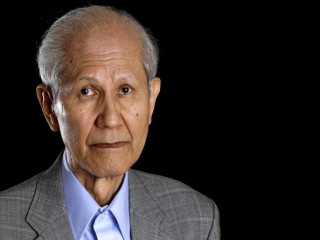
Osamu Shimomura biography
Date of birth : -
Date of death : -
Birthplace : Kyoto, Japan
Nationality : Japanese
Category : Science and Technology
Last modified : 2011-10-06
Credited as : Chemist, Nobel Prize in Chemistry,
0 votes so far
As a teenager, Osamu Shimomura was blinded for several weeks by the atomic bombing of Nagasaki. After his vision returned he studied biochemistry, and was assigned the challenge of explaining why some sea life glows. It was a subject of more than mere academic interest, as World War II submarines had been located and sunk after their undersea activity triggered flickering luminescence in nearby deep-sea creatures. In 1962, Shimomura discovered Green Fluorescent Protein (GFP) in the small, mouse-sized umbrella-shaped glowing jellyfish Aequorea victoria. In order to glow, Aequorea releases calcium ions which bind to a protein that he named aequorin, and that this molecular binding causes a glow. His discovery of GFP and investigations of numerous substrates and enzymes which lead to light emission have made Shimomura the world's preeminent expert on luminescent chemistry. Since his retirement in 2001, he has continued his research in the basement laboratory at his home. In 2008, he was awarded the Nobel Prize in Chemistry.
Born in Fukuchiyama, Kyoto in 1928, Shimomura was brought up in Manchukuo (Manchuria, China) and Osaka, Japan while his father served as an officer in the Imperial Japanese Army. Later, his family moved to Isahaya, Nagasaki, 15 miles from the epicenter of the August 1945 atomic bombing of the city. He recalls hearing, as a 16-year-old boy, the bomber plane before the atom bomb exploded. The explosion flash blinded Shimomura for about thirty seconds, and he was later drenched by the "black rain" bomb fallout. He overcame great odds in the following 11 years to earn an education and achieve academic success.
Shimomura worked in the Department of Biology at Princeton for Professor Johnson to study jellyfish Aequorea victoria, which they collected during many summers at the Friday Harbor Laboratories of the University of Washington. In 1962, their work culminated in the discovery of the proteins aequorin and green fluorescent protein (GFP) in the small, mouse-sized umbrella-shaped glowing jellyfish Aequorea victoria; for this work, he was awarded a third of the Nobel prize in Chemistry in 2008.
Honors:
Nobel Prize for Chemistry 2008 (with Martin Chalfie and Roger Y. Tsien)
Asahi Prize 2007
Pearse Prize 2004
Japanese Ancestry



















